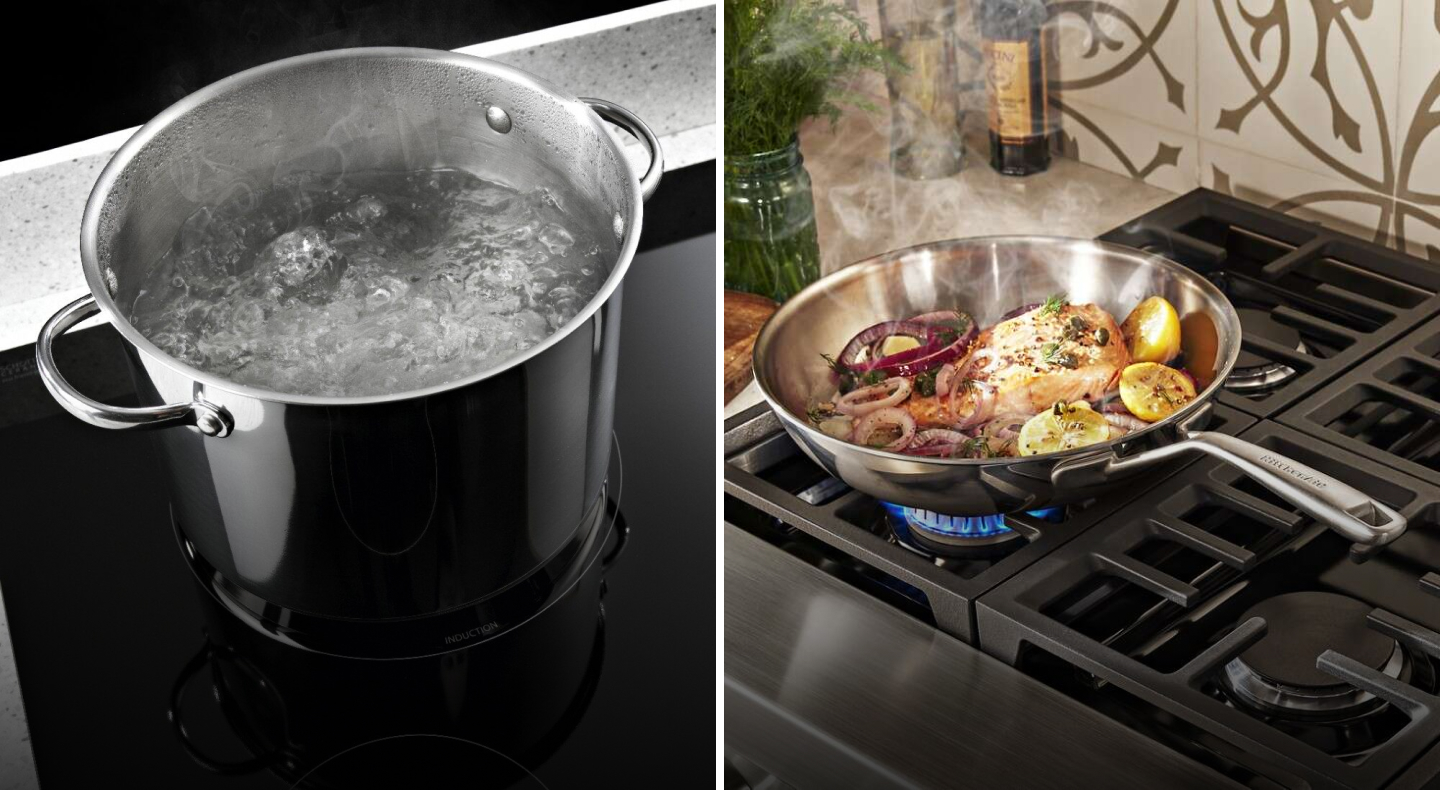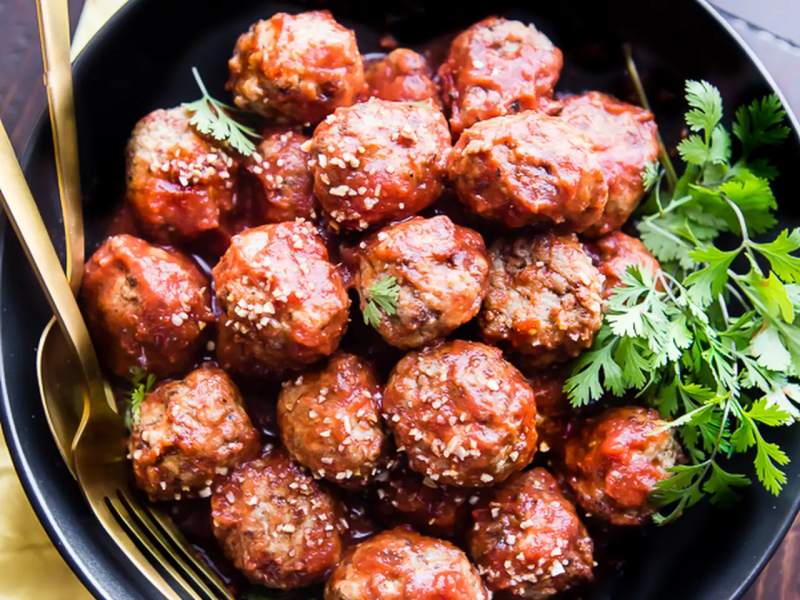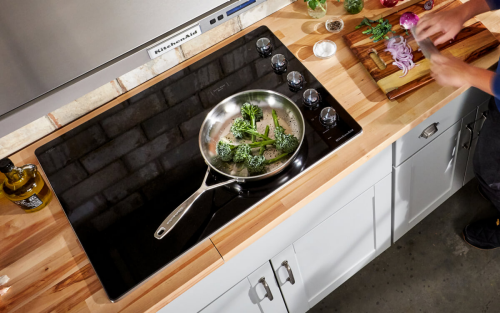
What is simmering? Tips and techniques
Setting your stovetop to a low and slow simmer can help you create rich, complex flavors and tender ingredients in soups, stews, sauces and even braised meats. Use this guide to learn more about what simmering is and how to achieve it, how it varies from boiling, sautéing, and how long to simmer different types of dishes.
What is simmering?
Simmering is a gentle method used to soften and combine fragile ingredients and spices on the stovetop. The temperature of the liquid in a simmering dish sits just below boiling point, usually somewhere between 185–205°F, to help you slow cook stews or braise meats for tender and flavorful dishes.
What does a simmer look like?
Like boiling, simmering can create bubbles that break the surface area of the water, but these bubbles are typically small, move slowly and only intermittently burst at the surface. A simmer can create small, subtle bubbling throughout the pot or bubbles that only arise around the perimeter of the dish.


What are the benefits of simmering?
Simmering can help you cook tender cuts of tough meats or thick vegetables. It can also slowly soften delicate food, help prevent ingredients from becoming mushy and give dishes time to incorporate deeper flavors.
Sauces, soups and stews may also call for simmering to help gradually thicken the consistency of the dish.

Learn more about types of cooktops

Find the right electric cooktop for you
What is the difference between simmering and boiling?
Boiling a dish causes more evaporation than simmering, cooking foods rapidly. Boiling occurs once a liquid’s temperature reaches at least 212°F. Simmering cooks food slowly and at slightly lower temperatures than boiling—usually between 185–205°F.
Simmering is best for dishes with ingredients prone to falling apart during the aggressive agitation of boiling. Simmering causes tiny bubbles that rise slowly, while boiling creates large bubbles that move rapidly.
How do you simmer?
Simmering requires enough liquid to partially or fully submerge any added ingredients, so start the process by filling your saucepan or stockpot with the liquid ingredients dictated by your recipe. Next, set the stovetop to low or medium heat until your dish reaches a simmer.
If you plan to add new ingredients to the pot, keep in mind that they may drop the temperature slightly and require you to return the dish to a simmer by slowly increasing the heat. A cooking thermometer may help you maintain a simmer.
Tips for achieving the perfect simmer
- Pay careful attention to how your recipe instructs you to bring the dish to a simmer. Some might advise bringing dishes to a boil, then lowering to a simmer rather than gradually working up to a simmer.
If a covered pot keeps approaching a boil, try keeping the lid off to promote air circulation over the pot and keep boiling at bay.
Stirring with a wooden or stainless steel spoon can bring down the temperature of your dish and help prevent simmering from progressing to a boil.
You can avoid overheating your dish by periodically removing the pot from the stovetop, then slightly lowering the heat before returning it to the stovetop to simmer.

KitchenAid® Temp Cook™ Induction Technology
Take on your next ambitious recipe
This KitchenAid® induction cooktop with Temp Cook™ Induction Technology maintains the precise temperature that you set for precise control beyond standard high, medium and low settings
Do you simmer with the lid on or off?
Your recipe’s instructions are your best guide when determining if a dish should simmer with the lid on or off. Dishes typically reach a simmer more quickly with the lid on, while those with the lid off may require a higher heat setting to achieve and maintain a steady simmer.


How long to simmer different types of food
The ideal simmering time largely depends on the consistency of a dish’s ingredients. Read below to learn roughly how long to simmer soups and stews, sauces, proteins and vegetables.

1. Soups and stews
Soups have a thinner consistency and tend to heat more quickly than stews, which need to simmer longer to tenderize thick cuts of meat and chopped vegetables. Aim to simmer stews like beef stew for about two to three hours, as any longer may lead to dried-out meat and mushy vegetables. Soups, on the other hand, can often simmer for as little as 25 minutes before they’re ready to serve.

2. Sauces
Simmering sauces like fresh tomato vodka sauce or Thai peanut dipping sauce can enhance their flavor and allows ingredients to thoroughly blend. Béchamel, or white sauces, typically simmer for up to 20 minutes, while Espagnole (brown sauce) and tomato sauces usually take anywhere from 45 minutes to 90 minutes to cook thoroughly. Buttery Hollandaise sauces contain egg yolks and should only be heated for a short time, to prevent the egg from scrambling. Veloute sauces (stock-based) typically simmer for about 15 minutes.

3. Proteins
You can simmer meats to create homemade stock, braise larger cuts or whip up dishes like gluten-free turkey meatballs or beef stew. Tough meats like shanks, rounds and shoulder cuts tenderize and absorb flavor the longer they cook, so they’ll simmer at a lower temperature than they would if frying or searing. You should be able to pull meat apart with a fork when it’s ready, which generally takes anywhere from 90 minutes to three hours on low heat.

4. Vegetables
Simmering time varies by the type of vegetable and the size of the cut, but you’ll typically start the process by bringing a small amount of water to a boil in a saucepan or stockpot, adding the vegetables and setting the heat to medium or low to maintain a steady simmer. Root vegetables like russet, Yukon or red and white potatoes take about 15 to 20 minutes to reach a tender consistency, while broccoli, Brussels sprouts, carrots or cauliflower may take anywhere from four to 12 minutes.

KitchenAid® cooktops
Cooktops made for every culinary adventure
KitchenAid® gas, electric and induction cooktops offer the versatility, performance and craftsmanship you need to create your favorite recipes
Explore KitchenAid® cooktops
KitchenAid brand offers gas, electric, induction and downdraft cooktops that deliver reliable heating designed for simmering soups, stews and more. Select cooktops feature dedicated simmering burners, like the 5K BTU Even-Heat™ Simmer Burner that uses a diffuser plate to allow more control of the flame at the lowest setting. Plus, versatile cooktop elements make it easy to fit cookware of all shapes and sizes.

KitchenAid® Hardware Accessory Kits
Curate the colors and textures that move you
From bold Black Ore to the inviting warmth of Bronze, mix and match handles and knobs to refresh your appliances and bring new energy to your kitchen
Was this article helpful? Pass it on
Explore more from KitchenAid brand
-
 Cooktop Sizes: Gas, Electric & Induction Looking for a cooktop with the right dimensions to fit your kitchen? Learn about standard cooktop sizes and how to measure a cooktop in this guide.
Cooktop Sizes: Gas, Electric & Induction Looking for a cooktop with the right dimensions to fit your kitchen? Learn about standard cooktop sizes and how to measure a cooktop in this guide. -
 Types of Cooktops & Stovetops: 5 Options to Consider A separate cooktop can transform your entire kitchen. Learn about the different types of cooktops and stovetops to find the best one for your cooking needs.
Types of Cooktops & Stovetops: 5 Options to Consider A separate cooktop can transform your entire kitchen. Learn about the different types of cooktops and stovetops to find the best one for your cooking needs. -
 What is an Induction Cooktop and How Does it Work? An induction cooktop may be just what your kitchen needs. Discover what an induction cooktop is, the benefits of using one and how induction cooking works.
What is an Induction Cooktop and How Does it Work? An induction cooktop may be just what your kitchen needs. Discover what an induction cooktop is, the benefits of using one and how induction cooking works.

